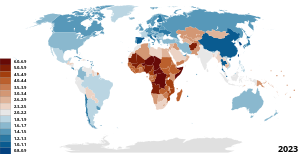Human population planning
Human population planning means managing the growth rate of a human population. This used to be called population control. In the past it was mostly about increasing populations. From the 1950s to the 1980s, concerns about overpopulation and its effects on poverty, the environment and political stability led to efforts to reduce population growth rates in many countries. More recently many countries such as China, Japan,[1][2] South Korea,[3] Russia,[4] Iran, Italy,[4] Spain, Finland,[5] Hungary[6] and Estonia[7][8] have begun efforts to boost birth rates once again.

Population planning can involve measures that improve people's lives by giving them greater control of their reproduction. In some place, like the Chinese government's "one-child policy and two-child policy", there have been punishments for families which had more children.
Types
changeThere are three types of population planning policies:
- Increasing or decreasing the overall population growth rate.
- Increasing or decreasing the relative population growth of a subgroup of people, such as those of high or low intelligence or those with special abilities or disabilities. Policies that aim to boost relative growth rates are known as positive eugenics; those that aim to reduce relative growth rates are known as negative eugenics.
- Attempts to ensure that all population groups of a certain type (e.g. all social classes within a society) have the same average rate of population growth.
Effects
changeSince 1980 many countries have tried family-friendly policies to increase the birth rate. They have spent more on child benefits, subsidised childcare, increased parental leave and tried other family-friendly policies. Birth rates in most countries have continued to fall. [9]
References
change- ↑ "Fears grow that Japan's birth rate and aging crisis could be worsened by pandemic". The Japan Times. 18 August 2020. Archived from the original on 4 August 2021. Retrieved 4 August 2021.
- ↑ "Japan to fund AI matchmaking to boost birth rate". BBC News. 8 December 2020. Retrieved 4 August 2021.
- ↑ Lee, David D. (27 December 2020). "Can South Korea lift the world's lowest birth rate by offering cash incentives?". South China Morning Post. Retrieved 4 August 2021.
- ↑ 4.0 4.1 "How do countries fight falling birth rates?". BBC News. 15 January 2020. Retrieved 4 August 2021.
- ↑ "Business lobby calls for govt action to boost Finland's birth rate". Yle.fi. 19 January 2020. Retrieved 4 August 2021.
- ↑ "Hungary tries for baby boom with tax breaks and loan forgiveness". BBC News. 11 February 2019. Retrieved 21 September 2021.
- ↑ Rooney, Katharine (12 November 2019). "This is how Estonia is growing its population". World Economic Forum. Retrieved 21 September 2021.
- ↑ Männi, Marian (11 July 2020). "Feature: Estonians starting to have more kids — because they can". ERR Online. Retrieved 21 September 2021.
- ↑ "Why family-friendly policies don't boost birth rates". www.ft.com. Retrieved 2024-03-29.